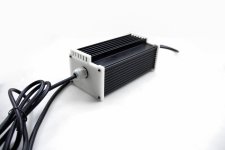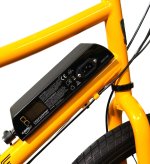scootergrisen said:
In some ways Meanwell HLG-600H-54A is sort of what i would like.
But I don't really trust it to be watertight.
I have seen the same kind of design with 2 end plates on controllers and DC-DC converters and they look really not tight.
The HLG series is potted and sealed; IP65 waterproof rating for the adjustable version, IP67 for the nonadjustable.
https://www.meanwell.com/Upload/PDF/HLG-600H/HLG-600H-SPEC.PDF
Nothing like the controllers you're thinking of (that are often at best somewhat moisture resistant). If that's not sufficient for your purposes, you'd need to find IP67 or higher, to survive being used under water at depth.

(BTW, the 600H does up to 11-12A charging, so you can use smaller ones if you don't need that high a charging current).
If it's helpful, this is the general meaning of the three "waterproof" IP ratings you're likely to see in this type of device (you can find all the IP ratings on various engineering sites) (sorry the table didn't come out aligned right in the quote)
IP Rating Protection Description Test Method
IP65 Enclosures Able to protect against water jets Water projected by a nozzle (6.3 mm) against enclosure from any direction shall have no harmful effects. Test duration: at least 15 minutes
Water volume: 12.5 litres per minute
Pressure: 30 kPa at distance of 3 m
IP66 Enclosures Able to protect against powerful water jets Water projected in powerful jets (12.5 mm nozzle) against the enclosure from any direction shall have no harmful effects. Test duration: at least 3 minutes
Water volume: 100 litres per minute
Pressure: 100 kPa at distance of 3 m
IP67 Enclosures Able to protect against Immersion up to 1 m Ingress of water in harmful quantity shall not be possible when the enclosure is immersed in water under defined conditions of pressure and time (up to 1 m of submersion). Test duration: 30 minutes
Immersion at depth of at least 1 m measured at bottom of device, and at least 15 cm measured at top of device
I'm no expert but constant current and constant voltage at the same time don't sound like something for charging batteries.
Well, CC/CV is how lithium battery chargers work (as well as LED PSUs), so if you don't want that, you'd have to specify exactly what you need it to do and how, so something other than a normal charger can be found that does do what you want.
None of these things can do CC and CV at the same time while charging a battery; it's not physically possible for most of the charge curve--you get CC while voltage increases until the internal resistance of the battery is enough to cause current to start decreasing. Then the current and voltage both change in opposite ways until the voltage reaches maximum and it stays at CV, and current continues to decrease until the BMS (if any) turns off it's charge port. If there's no BMS, it will continue at CV and some tiny current thru whatever the pack resistance is at that voltage until charging device power is removed.
My BMS has separate terminal for charging so i dont think it would be necessary with a switch/relay.
It is if the charging device (of whatever kind) does not have it's own automatic internal self-disconnect (which the LED PSUs don't, and some actual chargers don't either), because the charging port cannot prevent reverse current flow out of the charge port. (just like the discharge port cannot prevent reverse current flow (regen) into the discharge port). So when the charging device power is removed, it still has an internal resistance low enough to allow current flow back into it, dependent on the voltage present (from the pack still attached to it) on it's output wire. It's not much, but it's there, so it does present some drain on the pack, continuously. If (like the HLG I use) it has an LED to show output power state, it's probably directly connected to the output wire, so it will also be a small load on the pack, too.
For my use, the drain is insignificant while riding (a few dozen mA at worst), but because it is constant it could drain the pack past empty and damage it if I just let the system sit for a few days (or less), so I wired mine so the main shutoff switch for my trike also disconnects the charger. (in order to charge, I have to turn the trike on, which makes it hard for me to not notice that the charger is also connected since the Cycle Analyst display is lit up when the trike is on, even if I don't notice the charger and controller LEDs lighting up the underside of the trike).
If you had a common charge/discharge port on the BMS, you wouldn't need the switch or relay, because the BMS could actually turn the port off for both directions, and prevent draining the pack whenever the system is not in use, as long as you switch the BMS off so that it turns the ports off. It would still have the drain while using the system, since the discharge port has to be on to do that, so if the drain is significant enough (unlikely) you'd have to put a switch on the charging device output wire to prevent it.
It seems the charger can bee connected always and then when you power on the charger the BMS will turn off the discharging at the same time as the charging begins.
That depends on the BMS. Some turn off the discharge port during charging, some don't. If yours does, then it will shutdown the ability of the bike to operate whenever the BMS detects charging. This doesn't affect the charge port's inability to prevent discharge backwards thru it into the charging device's output when the charging device is not supplying more voltage than is present on the cell side of the charge port.







